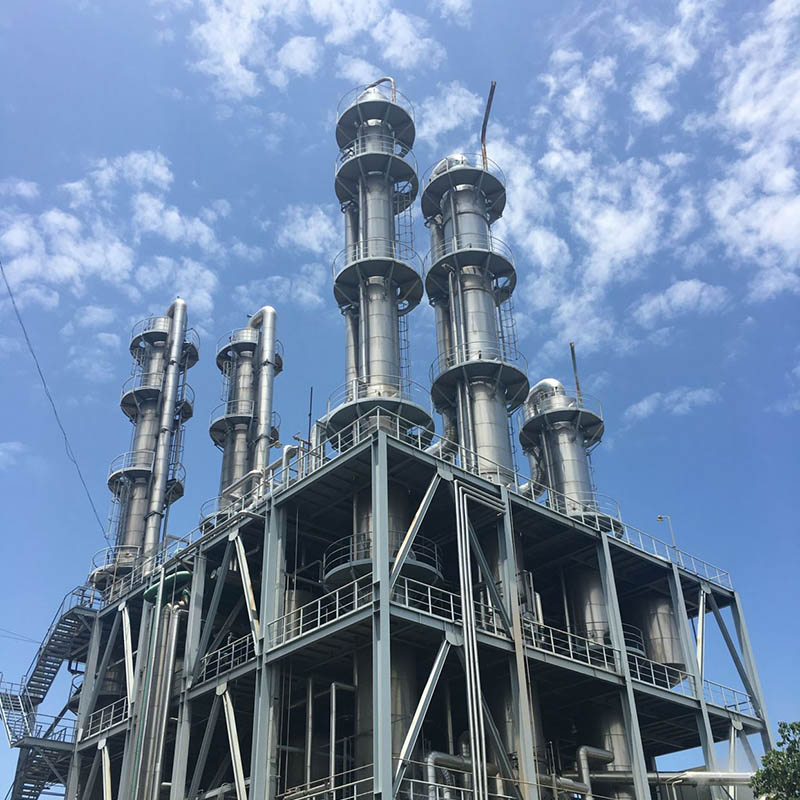Key Points about Industrial Distillation Columns Or Towers
2024-07-11
Industrial distillation columns or towers are essential components in the chemical, petrochemical, and refining industries. They are used to separate mixtures of liquids based on differences in their boiling points. Here are the key points about industrial distillation columns:
Key Components of Distillation Columns
1. Column Shell
- The outer cylindrical structure that contains the internal components.
- Made from materials resistant to the process chemicals and conditions, typically stainless steel or carbon steel.
2. Trays and Plates
- Internal components that provide surface area for vapor-liquid contact.
- Types include sieve trays, bubble cap trays, and valve trays.
- Efficiency determined by the design and number of trays.
3. Packing
- Alternative to trays, used in packed columns.
- Types include random packing (e.g., Raschig rings) and structured packing.
- Provides large surface area for vapor-liquid interaction.
4. Reboiler
- Located at the bottom of the column.
- Supplies heat to vaporize the liquid mixture, driving the separation process.
5. Condenser
- Located at the top of the column.
- Condenses the vapor leaving the top of the column back into liquid.
6. Feed Inlet
- The point where the mixture to be separated is introduced into the column.
7. Distillate Outlet
- The exit point for the condensed vapor, typically at the top of the column.
8. Bottoms Outlet
- The exit point for the liquid that collects at the bottom of the column after separation.
Types of Distillation Columns
1. Continuous Columns
- Operate continuously, with the feed entering and products being removed without stopping the process.
- Common in large-scale industrial operations.
2. Batch Columns
- Operate in batch mode, with the feed processed in discrete batches.
- Suitable for smaller operations or varying feed compositions.
Key Types of Distillation Processes
1. Fractional Distillation
- Used to separate mixtures with multiple components with close boiling points.
- Common in crude oil refining.
2. Vacuum Distillation
- Performed under reduced pressure to lower the boiling points of the components.
- Used for heat-sensitive materials or components with very high boiling points.
3. Azeotropic Distillation
- Used to break azeotropes, mixtures that have the same composition in liquid and vapor phases.
- Requires the addition of another component to change the relative volatility of the mixture.
4. Extractive Distillation
- Involves adding a solvent to alter the relative volatility of the components.
- The solvent is chosen to have a high affinity for one of the components in the mixture.
Applications
1. Petroleum Refining
- Separating crude oil into fractions like gasoline, diesel, kerosene, and lubricating oils.
2. Chemical Industry
- Purifying chemicals and separating reaction products.
3. Pharmaceuticals
- Producing high-purity solvents and active pharmaceutical ingredients.
4. Food and Beverage
- Producing spirits and ethanol.
Design Considerations
1. Feed Composition
- The nature and composition of the feed determine the column design and operating parameters.
2. Desired Purity
- The required purity of the distillate and bottoms products influences the number of stages or trays needed.
3. Energy Efficiency
- Design aims to minimize energy consumption, often through heat integration and optimized operating conditions.
4. Capacity
- The size and throughput of the column must meet the production requirements.
5. Control Systems
- Advanced control systems ensure stable operation and product quality, managing variables like temperature, pressure, and flow rates.
Challenges
1. Scaling Up
- Ensuring consistent performance when scaling up from pilot to industrial scale.
2. Energy Consumption
- Distillation is energy-intensive; improving efficiency is a major focus.
3. Fouling and Maintenance
- Preventing fouling and ensuring ease of maintenance are crucial for continuous operation.
4. Safety
- High temperatures and pressures require robust safety measures to prevent accidents.
Understanding these key points about industrial distillation columns or towers helps in grasping their complexity, importance, and the considerations necessary for their efficient and safe operation.



